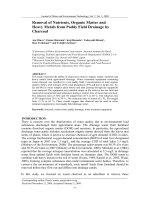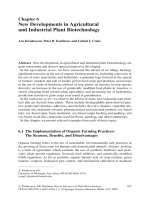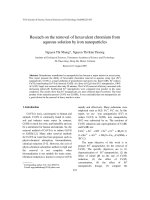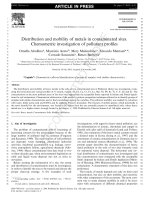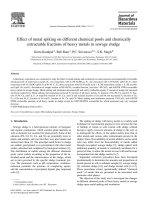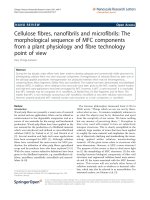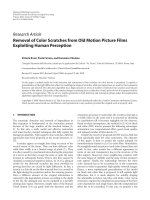Removal of heavy metals from wastewater using agricultural and industrial wastes as adsorbents
Bạn đang xem bản rút gọn của tài liệu. Xem và tải ngay bản đầy đủ của tài liệu tại đây (1.03 MB, 7 trang )
Removal of heavy metals from wastewater using
agricultural and industrial wastes as adsorbents
Hala Ahmed Hegazi
Housing, Building and Research Center, Egypt
Received 19 November 2012; accepted 10 March 2013
KEYWORDS
Adsorption;
Adsorbents;
Agricultural wastes;
Industrial waste;
Heavy metals;
Wastewater
Abstract Adsorption processes are being widely used by various researchers for the removal of
heavy metals from waste streams and activated carbon has been frequently used as an adsorbent.
Despite its extensive use in water and wastewater treatment industries, activated carbon remains
an expensive material. In recent years, the need for safe and economical methods for the elimination
of heavy metals from contaminated waters has necessitated research interest toward the production
of low cost alternatives to commercially available activated carbon. Therefore, there is an urgent
need that all possible sources of agro-based inexpensive adsorbents should be explored and their
feasibility for the removal of heavy metals should be studied in detail. The objective of this research
is to study the utilization possibilities of less expensive adsorbents for the elimination of heavy met-
als from wastewater. Agricultural and industrial waste by-products such as rice husk and fly ash
have be used for the elimination of heavy metals from wastewater for the treatment of the
EL-AHLIA Company wastewater for electroplating industries as an actual case study.
Results showed that low cost adsorbents can be fruitfully used for the removal of heavy metals
with a concentration range of 20–60 mg/l also, using real wastewater showed that rice husk was
effective in the simultaneous removal of Fe, Pb and Ni, where fly ash was effective in the removal
of Cd and Cu.
ª 2013 Housing and Building National Research Center. Production and hosting by Elsevier B.V.
All rights reserved.
Introduction
Excessive release of heavy metals into the environment due to
industrialization and urbanization has posed a great problem
worldwide. Unlike organic pollutants, the majority of which
are susceptible to biological degradation, heavy metal ions
do not degrade into harmless end products [1]. The presence
of heavy metal ions is of major concern due to their toxicity
to many life forms. Heavy metal contamination exists in aque-
ous wastes of many industries, such as metal plating, mining
operations, tanneries, chloralkali, radiator manufacturing,
smelting, alloy industries and storage batteries industries [2].
Treatment processes for heavy metal removal from waste-
water include precipitation, membrane filtration, ion exchange,
adsorption, and co-precipitation/adsorption. Studies on the
treatment of effluent bearing heavy metals have revealed
E-mail address:
Peer review under responsibility of Housing and Building National
Research Center.
Production and hosting by Elsevier
HBRC Journal (2013) 9, 276–282
Housing and Building National Research Center
HBRC Journal
/>1687-4048 ª 2013 Housing and Building National Research Center. Production and hosting by Elsevier B.V. All rights reserved.
/>adsorption to be a highly effective technique for the removal of
heavy metals from waste stream and activated carbon has been
widely used as an adsorbent [3]. Despite its extensive use in
water and wastewater treatment industries, activated carbon
remains an expensive material.
In recent years, the need for safe and economical methods
for the elimination of heavy metals from contaminated waters
has necessitated research Low cost agricultural waste by-prod-
ucts such as sugarcane bagasse [4–8], Rice husk [9–13], sawdust
[14–16], coconut husk [17], oil palm shell [18], neem bark [19]
etc., for the elimination of heavy metals from wastewater have
been investigated by various researchers. Cost is an important
parameter for comparing the sorbent materials. However, cost
information is seldom reported, and the expense of individual
sorbents varies depending on the degree of processing required
and local availability. In general, an adsorbent can be termed
as a low cost adsorbent if it requires little processing, is abun-
dant in nature, or is a by-product or waste material from an-
other industry. Of course improved sorption capacity may
compensate the cost of additional processing [20]. Therefore
there is an urgent need that all possible sources of agro-based
inexpensive adsorbents should be explored and their feasibility
for the removal of heavy metals should be studied in detail.
The objective of this study is to contribute in the search for less
expensive adsorbents and their utilization possibilities for var-
ious agricultural waste by-products, which are in many cases
also pollution sources.
Relevant literature
Reviews of some agricultural and industrial adsorbents for the
removal of heavy metals from wastewater are presented as
follows.
Rice husk
Rice husk is an agricultural waste material generated in rice
producing countries, especially in Egypt. The annual world
rice production is approximately 500 million metric tons, of
which 10–20% is rice husk. Dry rice husk contains 70–85%
of organic matter (lignin, cellulose, sugars, etc.) and the
remainder consists of silica, which is present in the cellular
membrane [21]. In recent years, attention has been focused
on the utilization of unmodified or modified rice husk as an
adsorbent for the removal of pollutants. Batch studies using
tartaric acid modified rice husk as adsorbent have been carried
out for the removal of lead and copper and have reported the
effects of various parameters such as pH, initial concentration
of adsorbate, particle size, temperature etc. It was reported
that modified rice husk is a potentially useful material for
the removal of Cu and Pb from aqueous solutions [22].
Fly ash
Fly Ash is a naturally-cementations coal combustion by-prod-
uct. It is extracted by the precipitators in the smokestacks of
coal-burning power plants to reduce pollution Since the fly
ash disposal problem emerged with the advent of pollution
control systems in the 1960’s and 1970’s, extensive research
has been done to understand how it performs in its orthodox
Table 1 Low cost adsorbents data.
Low cost adsorbents Main consistent Primary source Physical structure Chemical characterization (%) Primary use
Rice husk Is collected from one
of the rice processing factories
Rice Granular structure
insolubility in water, chemical
stability, high mechanical strength
and its local availability at almost
no cost
Cellulose 32.2 Wastewater treatment
Hemicellulose 21.3
Lignin 21.4
Extractives 1.82
Water 8.11
Fly ash A particulate material produced
from the combustion of coal
in power plants
Bituminous
coal-burning
power
plant
Spherical shape
and pozzolanic properties
SiO
2
57.82 Building materials, soil amendment and fillers
Al
2
O
3
22.10
Fe
2
O
3
8.33
Removal of heavy metals from wastewater 277
capacity – as a soil stabilizer and structural concrete admixture
[23].
Experimental works
Materials
The adsorption of heavy metal ions by low cost adsorbents
was evaluated under various conditions such as pH, heavy me-
tal concentration, mixing speed and adsorbent dose through
both kinetic and isotherm studies. The optimum removal
condition was also identified for each metal ion. Table 1 indi-
cates the main consistent, primary source, physical structure,
chemical characterization and the primary use of low cost
adsorbents such as rice husk and fly ash (see Figs. 1 and 2).
Batch study (synthetic wastewater)
Metal solutions of (Cu, Ni, Fe) were prepared by dissolving
copper sulfate (CuSO
4
Æ5H
2
O), nickel nitrate (NiNO
3
)
2
Æ6H
2
O
and iron sulfate (FeSO
4
Æ7H
2
O) separately in double distilled
water in order to result in known concentrations of the metal
ions required and to make synthetic wastewater.
All the experiments were carried out in duplicate and the
relative standard deviation was less than 5%. In general the
sorption consisted of 20 mg/l for the adsorbent dose in
Fig. 1 Experimental work program for rice husk.
Fig. 2 Experimental work program for fly ash.
278 H.A. Hegazi
10 mg/l of concentration metal (Cu, Ni, Fe) at an agitation
rate of 200 rpm with an adsorbent time of 20 min at room tem-
perature (25 ± 3).To study the effect of pH on sorption, the
pH of the metal ion solution was adjusted to values in the
range of (2–10) by the addition of CuSO
4
Æ5H
2
O, (NiNO
3
)2Æ6-
H
2
O, FeSO
2
Æ7H
2
O prior to the experiment. The Langmuir iso-
therms were obtained by equilibrating metal ion solutions of
different adsorbent doses (5–30) mg/l with different times
(20–150 min) at equilibrium pH and rpm with an initial metal
concentration of 10 mg/l at room temperature.
The effect of agitation rate on metal ion uptake was carried
out by varying the agitation rate from 50 to 200 rpm, and the
Fig. 3 Heavy metal concentration in El-AHLIA wastewater.
Table 3 Fe removal efficiency for different absorbent doses.
Heavy metal Adsorbent dose In- Fe mg/l Rice husk Fly ash
Outlet-Fe mg/l Removal ratio % Outlet-Fe mg/l Removal ratio %
Fe 20 11.78 3.7 68.59 6.34 46.18
30 11.78 2.1 82.17 4.9 58.4
40 11.78 1.2 89.81 4.1 65.2
50 11.78 0.09 99.236 2.97 74.788
60 11.78 0.088 99.253 1.56 86.757
Table 4 Pb removal efficiency for different absorbent doses.
Heavy metal Adsorbent dose In- Pb mg/l Rice husk Fly ash
Outlet- Pb mg/l Removal ratio % Outlet- Pb mg/l Removal ratio %
Pb 20 1.17 0.91 22.22 0.92 21.79
30 1.17 0.66 43.59 0.7 40.17
40 1.17 0.38 67.52 0.46 60.68
50 1.17 0.28 76.068 0.33 71.795
60 1.17 0.15 87.179 0.28 76.068
Table 2 Experimental work program (synthetic water).
Low cost adsorption Run Metals pH Mixing speed (rpm) Contact time (min) Adsorbent dose (g/l)
Rice husk 1 Cu 3:10 200 20 10
2 5 50:250 20 10
3 5 200 20:150 5:30
4 5 200 120 20
5 Ni 2:7 200 20 10
6 6 50:250 20 10
7 6 200 20:150 5:30
8 6 200 120 20
9 Fe 2.5:4 200 20 10
10 3.75 50:250 20 10
11 3.75 200 20:150 5:30
12 3.75 200 120 20
Fly ash 13 Cu 3:8 200 20 10
14 6 50:250 20 10
15 6 150 20:150 5:40
16 6 150 120 20
17 Ni 3:10 200 20 10
18 7 50–250 20 10
19 7 150 20:150 5:40
20 7 150 120 20
21 Fe 3:8 200 20 10
22 6 50:250 20 10
23 6 150 20:150 5:40
24 6 150 120 20
Removal of heavy metals from wastewater 279
experiment on the effect of an adsorbent dose of 20 mg/l at
equilibrium pH and rpm at an adsorbent time of 20 min with
a concentration of 5–30 mg/l at room temperature.
Adsorption batch experiments
Adsorption batch experiments were carried out by shaking a
series of bottles containing various amounts of each of the
Table 5 Cd removal efficiency for different absorbent doses.
Heavy metal Adsorbent dose In- Cd mg/l Rice husk Fly ash
Outlet- Cd mg/l Removal ratio % Outlet- Cd mg/l Removal ratio %
Cd 20 0.48 0.36 26.04 0.36 25.21
30 0.48 0.31 35.42 0.30 37.50
40 0.48 0.24 50.00 0.23 52.08
50 0.48 0.190 60.417 0.180 62.500
60 0.48 0.154 67.917 0.127 73.542
Table 6 Cu removal efficiency for different absorbent doses.
Heavy metal Adsorbent dose In- Cu mg/l Rice husk Fly ash
Outlet- Cu mg/l Removal ratio % Outlet- Cu mg/l Removal ratio %
Cu 20 5.43 4.10 24.49 3.40 37.38
30 5.43 2.84 47.70 1.81 66.67
40 5.43 1.83 66.30 1.01 81.40
50 5.43 1.210 77.716 0.089 98.361
60 5.43 0.099 98.177 0.079 98.545
Fig. 4 Removal efficiency of various heavy metals using rice
husk.
Fig. 5 Removal efficiency of various heavy metals using fly ash.
Fig. 6 Comparison between rice husk and fly ash removal
efficiency at 60 mg/l absorbent concentration.
Fig. 7 Comparison between rice husk and fly ash removal
efficiency at 50 mg/l absorbent concentration.
280 H.A. Hegazi
low cost adsorbents and heavy metal ions at different pH. The
pH of the slurry was adjusted to a desired value in the range of
2–10 and was agitated in a shaking bath at (25 ± 3 °C) for
20 min until the pH was stabilized. Then, the nickel, iron
and copper ions in the form of CuSO
4
Æ5H
2
O, (NiNO
3
)
2
Æ6H
2
O,
FeSO
4
Æ7H
2
O were added to the bottles to make initial concen-
trations of 5–30 mg/L and the bottles were further agitated for
2 or 2.5 h until equilibrium was obtained. The residual concen-
tration of heavy metals was determined by an atomic absorp-
tion spectrometer. In addition to adsorption tests, a set of
blank tests of low cost were conducted in order to evaluate
the removal by metal hydroxide precipitation at various pH’s.
Table 2 indicates the experimental work program i.e. mix-
ing speed, contact time and adsorbent dose.
Case of study: treatment of wastewater in EL-AHLIA Company
for electroplating industries
The wastewater produced from the EL-AHLIA Company is
750 m
3
/day and discharged into the sewer system of the Isma-
ilia canal in Abozabal. Wastewater from the electroplating
department of 250 m
3
/day represents the main source of pollu-
tion in this company. The unreacted rinse water contains high
concentrations of Fe, Pb, Cd, Cu and Ni. Their typical concen-
trations were as high as 11.78, 1.17, 0.48, 5.43 and 1.74 mg/l
respectively (see Fig. 3).
Results and discussion
Fe removal by different weights of absorbents
The effect of the amount of adsorbent on the removal of Fe
ions by rice husk is depicted in Table 3 for varied adsorbent
doses of 20, 30, 40, 50 and 60 mg/l. Fe removal using rice husk
increased from 68.59% to 99.25% i.e. with the increase of the
amount of absorbent concentration , while Fe removal using
fly Ash varied from 46.18% to 86.757%.
Pb removal by different weights of absorbents
The effect of the amount of adsorbent on the removal of Pb
ions by rice husk is depicted in Table 4 for varied adsorbent
doses of 20, 30, 40, 50 and 60 mg/l. Pb removal with rice husk
increased from 22.22% to 87.17% i.e. with the increase of the
amount of absorbent concentration, while the Pb removal
using fly Ash varied from 21.79% to 76.06%.
Cd removal by different weights of absorbents
The effect of the amount of adsorbent on the removal of Cd
ions by rice husk is depicted in Table 5 for varied adsorbent
doses of 20, 30, 40, 50 and 60 mg/l. Cd removal using rice husk
increased from 26.04% to 67.917% i.e. with the increase of the
amount of absorbent concentration, while the Cd removal
using fly Ash varied from 25.21% to 73.54%.
Cu removal by different weights of absorbents
The effect of the amount of adsorbent on the removal of Cu
ions by rice husk is depicted in Table 5 for varied adsorbent
doses of 20, 30, 40, 50 and 60 mg/l. Cu removal using rice husk
increased from 24.49% to 98.177% i.e. with the increase of the
amount of absorbent concentration , while Cu removal using
fly Ash varied from 37.38% to 98.545% (see Table 6).
Ni removal by different weights of absorbents
The effect of the amount of adsorbent on the removal of Ni
ions by rice husk is depicted in Table 5 for varied adsorbent
doses of 20, 30, 40, 50 and 60 mg/l. Ni removal using rice husk
increased from 94.885% to 96.954% i.e. with the increase of
the amount of absorbent concentration , while Ni removal
using fly Ash varied from 94.540% to 96.034% (see Figs. 4–
7, Table 7).
Conclusion
1. Results showed that low cost adsorbents can be fruitfully
used for the removal of heavy metals with a concentration
range of 20–60 mg/l.
2. The results of using real wastewater showed that rice husk
was effective in the simultaneous removal of Fe, Pb and Ni,
whereas fly ash was effective in the removal of Cd and Cu.
3. It was found that the percentage removal of heavy metals
was dependent on the dose of low cost adsorbent and
adsorbent concentration.
4. The contact time necessary for maximum adsorption was
found to be two hours.
5. The optimum pH range for heavy metal adsorption was
6–7.0.
References
[1] V.K. Gupta, M. Gupta, S. Sharma, Process development for the
removal of lead and chromium from aqueous solution using red
mud – an aluminum industry waste, Water Res. 35 (5) (2001)
1125–1134
.
[2] K. Kadirvelu, K. Thamaraiselvi, C. Namasivayam, Removal of
heavy metal from industrial wastewaters by adsorption onto
Table 7 Ni removal efficiency for different absorbent doses.
Heavy metal Adsorbent dose In- Ni mg/l Rice husk Fly ash
Outlet- Ni mg/l Removal ratio % Outlet- Ni mg/l Removal ratio %
Ni 20 1.74 0.089 94.885 0.095 94.540
30 1.74 0.071 95.920 0.085 95.115
40 1.74 0.065 96.264 0.076 95.632
50 1.74 0.058 96.667 0.070 95.977
60 1.74 0.053 96.954 0.069 96.034
Removal of heavy metals from wastewater 281
activated carbon prepared from an agricultural solid waste,
Bioresour. Technol. 76 (2001) 63–65
.
[3] S. Chand, V.K. Aggarwal, P. Kumar, Removal of hexavalent
chromium from the wastewater by adsorption, Indian J.
Environ. Health 36 (3) (1994) 151–158.
[4] D. Mohan, K.P. Singh, Single and multi-component adsorption
of cadmium and zinc using activated carbon derived from
bagasse – an agricultural waste, Water Res. 36 (2002) 2304–
2318
.
[5] N.A. Khan, S.I. Ali, S. Ayub, Effect of pH on the removal of
chromium (Cr) (VI) by sugar cane baggase, Sci. Technol. 6
(2001) 13–19.
[6] S. Ayub, S.I. Ali, N.A. Khan, R.A.K. Rao, Treatment of
wastewater by agricultural waste, Environ. Prot. Control J. 2 (1)
(1998) 5–8.
[7] S. Ayub, S.I. Ali, N.A. Khan, Study on the removal of Cr(VI) by
sugarcane bagasse from wastewater, Pollut. Res. J. 2 (2) (2001)
233–237.
[8] S. Ayub, S.I. Ali, N.A. Khan, Adsorption studies on the low
cost adsorbent for the removal of Cr(VI) from electroplating
wastewater, Environ. Pollut. Control J. 5 (6) (2002) 10–20
.
[9] K. Srinivasan, N. Balasubramaniam, T.V. Ramakrishna,
Studies on chromium removal by rice husk carbon, Indian J.
Environ. Health 30 (4) (1998) 376–387
.
[10] E. Munaf, R. Zein, The use of rice husk for removal of toxic
metals from wastewater, Environ. Technol. 18 (1970) 359–362
.
[11] M. Ajmal, R.A.K. Rao, S. Anwar, J. Ahmad, R. Ahmad,
Adsorption studies on rice husk: removal and recovery of Cd
(II) from wastewater, Bioresour. Technol. 86 (2003) 147–149
.
[12] R. Suemitsu, R. Venishi, I. Akashi, M. Nakano, The use of
dyestuff-treated rice hulls for removal of heavy metals from
waste water, J. Appl. Polym. Sci. 31 (1986) 75–83
.
[13] N.A. Khan, M.G. Shaaban, Z. Jamil, Chromium removal from
wastewater through adsorption process, in: Proc. UM Research
Seminar 2003 organized by Institute of Research Management
and Consultancy (IPPP), University of Malaya, Kuala Lumpur,
2003.
[14] M. Ajmal, R.A.K. Rao, B.A. Siddiqui, Studies on removal and
recovery of Cr (VI) from electroplating wastes, Water Res. 30 (6)
(1996) 1478–1482
.
[15] K. Kadirvelu, M. Kavipriya, C. Karthika, M. Radhika, N.
Vennilamani, S. Pattabhi, Utilization of various agricultural
wastes for activated carbon preparation and application for the
removal of dyes and metal ions from aqueous solution,
Bioresour. Technol. 87 (2003) 129–132
.
[16] K. Selvi, S. Pattabhi, K. Kadirvelu, Removal of Cr (VI) from
aqueous solution by adsorption onto activated carbon,
Bioresour. Technol. 80 (2001) 87–89
.
[17] W.T. Tan, S.T. Ooi, C.K. Lee, Removal of chromium (VI) from
solution by coconut husk and palm pressed fibre, Environ.
Technol. 14 (1993) 277–282
.
[18] N.A. Khan, M.G. Shaaban, MH.A. Hassan, Removal of heavy
metal using an inexpensive adsorbent, in: Proc. UM Research
Seminar organized by Institute of Research Management and
Consultancy (IPPP), University of Malaya, Kuala Lumpur,
2003.
[19] S. Ayub, S.I. Ali, N.A. Khan, Efficiency evaluation of neem
(Azadirachta indica) bark in treatment of industrial wastewater,
Environ. Pollut. Control J. 4 (4) (2001) 34–38.
[20] S.E. Bailey, T.J. Olin, R.M. Bricka, D.D. Adrian, A review of
pontentially low-cost sorbents for heavy metals, Water Res. 33
(11) (1999) 2469–2479
.
[21] R.K. Vempati, S.C. Musthyala, Y.A. Molleh, D.L. Cocke,
Surface analyses of pyrolysed rice husk using scanning force
microscopy, Water Res. 74 (11) (1995) 1722–1725
.
[22] K.K. Wong, C.K. Lee, K.S. Low, M.J. Haron, Removal of Cu
and Pb by tartaric acid modified rice husk from aqueous
solution, Chemosphere 50 (2003) 23–28.
[23] W.E. Marshall, L.H. Wartelle, D.E. Boler, M.M. Johns, C.A.
Toles, Enhanced metal adsorption by soybean hulls modified
with citric acid, Bioresour. Technol. 69 (1999) 263–268.
282 H.A. Hegazi

